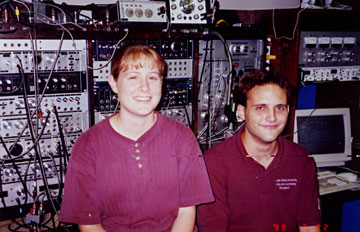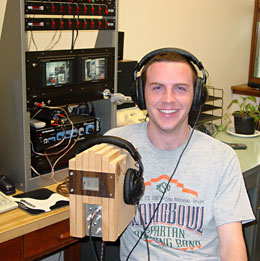
SIGNAL DETECTION

Signal detection theory has been the dominant psychoacoustical paradigm
since the 1960s. The contributions that our group has made to this
field have primarily involved the role of fluctuations and modulation
on detection, or the detection of these variations themselves.
The following references summarize our experimental and theoretical
work in this area.
References
"Theory of frequency modulation detection for low modulation frequencies" W.M. Hartmann and M.A. Klein, J. Acoust. Soc. Am. {67}, 935-946 (1980).
"A characteristic function equation for two-interval forced-choice experiments," W.M. Hartmann, J. Acoust. Soc. Am. {68}, 351-352 (1980).
"The effect of uncertainty on the detection of fm for low modulation frequencies," W.M. Hartmann and M.A. Klein, Percep. and Psychophysics {30}, 417-424 (1981)
"On the detection of a tone masked by two tones," W.M. Hartmann, J. Acoust. Soc. Am. {71}, 127-132 (1982).
"Detection of mixed modulation," W.M. Hartmann and G.M. Hnath, Acustica {50}, 297-312 (1982).
"Discrimination of spectral density," W.M. Hartmann, Stephen McAdams, Andrew Gerszo, and Pierre Boulez, J. Acoust. Soc. Am. {79}, 1915-1925 (1986).
"Noise power fluctuations and the masking of sine signals," W.M. Hartmann and Jon Pumplin, J. Acoust. Soc. Am. {83}, 2277-2289, (1988).
"Periodic signals with minimal power fluctuations," W.M. Hartmann and Jon Pumplin, J. Acoust. Soc. Am. {90}, 1986-1999 (1991).
"Periodic signals with minimal power fluctuations - Extended Tables ," W.M. Hartmann and Jon Pumplin, Physics Aux. Publ. Service PAPS JASMA-90-1986-15 (1991).

Colleen and Tim at the controls in the headphone lab.
"Turning on a tone," W.M. Hartmann and Dan Sartor, J. Acoust. Soc. Am. {90}, 866-873 (1991).
"Auditory demonstrations on compact disk for large N," W.M Hartmann, J. Acoust. Soc. Am. {Review and Tutorial} {93}, 1-16 (1993).
"The masking level difference in low-noise noise," J.W. Hall, J.H. Grose, and W.M. Hartmann, J. Acoust. Soc. Am. {103}, 2573-2577 (1998)."Release from speech-on-speech masking by adding a delayed masker at a different location," B. Rakerd, N.L. Aaronson, and W.M. Hartmann, J. Acoust. Soc. Am. {119}, 1597-1605 (2006).
"Matching the waveform and the temporal window in the creation of experimental signals," W.M. Hartmann and E.M. Wolf J. Acoust. Soc. Am. {126}, 2580-2588 (2009).
Further references
"Software structures for experiments in psychoacoustics," W.M. Hartmann, {Proceedings of the Research Symposium on the Psychology and Acoustics of Music - 1985}. ed. G.C. Turk.
"Temporal fluctuations and the discrimination of spectrally dense signals by human listeners," W.M. Hartmann, in {Auditory Processing of Complex Sounds}, eds. W.A. Yost and C.S. Watson, Lawrence Erlbaum, pp. 126-135, (1987).
"Digital waveform generation by fractional addressing," W.M. Hartmann, J. Acoust. Soc. Am. {82}, 1883-1891, (1987).
Review: A.J.M. Houtsma, T.D. Rossing, and W.M. Wagenaars, {Auditory Demonstrations on Compact Disc}, W.M. Hartmann, J. Acoust. Soc. Am. {85}, 521-522 (1989).
"Auditory demonstrations on compact disc for large N," [Review and Tutorial] J. Acoust. Soc. Am. {93}, 1-16 (1993).
"The Physics of the Auditory Stimulus," in {Hearing - The Handbook of Perception and Cognition}, Chapter 1, ed. B.C.J. Moore, Academic (1995)

Ben did the electronics for Wooden Head, our standard for headphone calibration with machined aluminum 6-cc couplers for ears.
Review: Now Hear This - The Life of Hugh S. Knowles, Acoustical Engineer and Entrepreneur, by Susan Goodwillie, reviewed by W.M. Hartmann for Ear and Hearing {21}, 536 (2000).
"Review of {Psychoacoustics: Facts and Models} by E. Zwicker and H. Fastl, W.M. Hartmann, Physics Today, pp 64-65, (June 2001).
"Acoustic signal processing," chapter 14 in Handbook of Acoustics, ed. T.D./ Rossing, Springer, pp 503-530. (2007).
"Relevance of theory in psychoacoustics," J. Acoust. Soc. Am. (abst) {125, 2564 (2009).